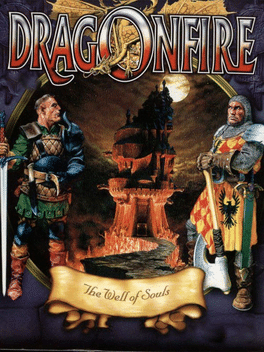Most Popular Xbox360 Games - Page 316
-
Dragonfire: The Well of Souls
1999
Based on the Swedish pen & paper RPG "Drakar och demoner", Dragonfire: The Well of Souls is an isometric RPG where you're tasked with defeating the evil arch magician Vicotnik, determined to conquer the world of Ereb Altor. -
Ultima Online: Samurai Empire
2004
Samurai Empire is the seventh edition (sixth expansion) of Ultima Online. It adds unique Japanese-themed content, such as the new Ninja and Samurai professions, as well as a new landmass, the Tokuno Islands (the Land of the Feudal Lords first introduced in Ultima I). This expansion also introduces a powerful new guild system, new dungeons, enhancements to the house customization system, and a whole collection of new monsters, weapons, and wearable items. -
Ultima Online: The Second Age
1998
Ultima Online: The Second Age is the first expansion for Ultima Online. -
The Aethra Chronicles, Volume One: Celystra's Bane
1994
A fantasy roleplaying game developed by Michael Lawrence and released as shareware. -
Warriors of Legend
1993
-
Dunjonquest: Upper Reaches of Apshai
1981
Expansion module for "Dunjonquest: Temple of Apshai" containing 150 more rooms split into four epsiodes. -
Summon Night Ex-These: Yoake no Tsubasa
2005
Summon Night Ex-These is a spin-off of the Summon Night series, released for the Playstation 2 on August 4, 2005 . The player takes control of Leonus & Ainna, two adventurers that wake up in a cave to find out that not only they lost their memories, but are also sharing the same body. They go on a journey to look for the mysterious Nova, who might know something about their past. The character you choose at the start becomes the lead in the story and the true owner or the body, the other one still participates in the plot as a sub-protagonist. Normally, they are not able to talk with each others, but using the “Stone of the Everlasting Night” they can meet inside an artificial world. -
MetalHeart: Replicants Rampage
2005
Metalheart: Replicants Rampage is a role-playing game with a turn-based combat system and a huge game world designed in classical cyberpunk style.The characters live in the dark post-apocalyptic world inhabited by four different races: humans, mutants, cyborgs and mysterious nomads. The player can form a party of up to 6 members with characters belonging to any of the four races. To complete some quests, a player will have to hire different specialists proficient in some particular skill, like snipers, demolishers, welders and many more. -
EverQuest: The Scars of Velious
2000
Scars of Velious is the second expansion for the popular MMORPG EverQuest. -
Gods: Lands of Infinity
2006
Gods: Lands of Infinity is a blend of adventure and action in a turn-based setting. There is an array of missions and NPCs who players can add to their team. Players must fight, gain experience, level and acquire new skills. The game is played out in the first-person perspective, until gamers enter a battle encounter, at which point the game goes into third-person turn-based mode. -
Magna Carta: The Phantom of Avalanche
2001
While it was never localized for western audiences, Magna Carta: The Phantom of Avalanche is notable for being the first entry in the Magna Carta series, developed and published by Softmax in Korea for Windows in 2001. -
Jagur 5
1987
-
The Desolate Room
2007
The Desolate Room
2007
The Desolate Room is a prequel to The Desolate Hope. I made this game over ten years ago but I think it's still a pretty good game. It's more difficult than most of my other games, so this is not for casuals. -
Aeon Avenger
2011
Aeon Avenger
2011
Aeon Avenger is a RPG where you can experience space-time travel. You can time-travel across thousands of years through the past, present and future. The map, characters, associations, and people’s relationships change over time! The key to a problem in this era may lie in another time. -
Gingiva
2013
Gingiva
2013
Surreal RPG from Middens author, Gingiva features seven playable characters, more than 5 hours of gameplay, over 100 fully animated creature portraits, multiple paths and varied endings. -
Shrink 'High
RPG Maker game about being shrunk by evil school girls -
Teudogar and the Alliance with Rome
2003
Teudogar is a RPG set in Rome during the time of emperor Augustus. You are playing a member of a Teutonic city named Teudogar and your tribe is faced with the question whether to arrange a alliance with Rome or to unify the Teutonic tribes to fight them. The main feature of this game is the historical accuracy. Every aspect of the game world is researched to align with the historical facts. There is even a whole encyclopedia included. Otherwise it is a RPG in the style of Ultima VII: You explore the world in a isometric perspective, talk to a lot of people and solve quests. You have a lot of freedom what to do and what not do do - you can explore the world or concentrate on the plot. Combat is complete turn based but if you are wounded your combat abilities start to decrease dramatically. The character system is based on "learning by doing" - if you use a certain weapon you get better in using it. There are no experiment points. The interface and the movement are completely mouse-controlled. -
Dragon Raja
2019
Dragon Raja
2019
MMORPG based on ancient tales. The Dragon Lord, once sealed away by a group of humans known as hybrids, has come back to life. The hybrids—humans gifted with superpowers—are gathering to prepare for the coming battle which is sure to be an epic showdown. -
.hack//Link
2010
.hack//Link
2010
Set in a fictional version of the year 2020, .hack//Link's story takes place in a new version of “The World,” a popular series of MMORPGs known as The World: RX. The game focuses on a young man named Tokio Kuryuu, a second year junior-high student who gets transported into The World: RX by a new student named Saika Amagi. After arriving into the game, Tokio is tasked by an artificial intelligence version of the character Kite to be a hero and use a tower of the Akashic Records to save the Twilight Knights, a group of artificial intelligence versions of characters based on casts of previous entries in the .hack series. Using the Akashic Records, Tokio is able to travel backwards in time to previous .hack entries and encounter past characters in order to unfreeze the data of the Twilight Knights. -
Phantasy Star Zero Mini
2009
Phantasy Star 0 Mini is an RPG developed by Sonic Team and published by Sega. It is a DSiWare adaptation of Phantasy Star 0 that was released only in Japan, and is Sega's only game sold through DSiWare.



















